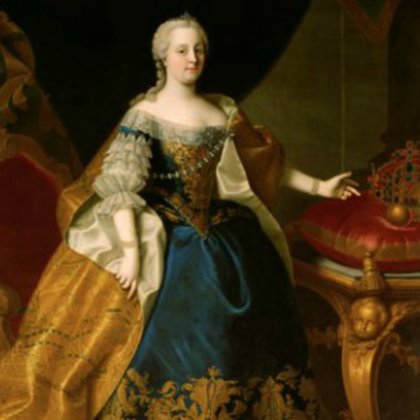AUSTRIA'S EMPRESS MARIA THERESA (1717 – 1780) AND THE POLITICS OF HABSBURG IMPERIAL,KNOWN AS THE EMPRESS WHO RULED THE HOLY ROMAN EMPIRE FROM VIENNA FOR 40 YEARS.SHE WAS MOTHER OF 16 CHILDREN , RULER OF MOST EUROPE.
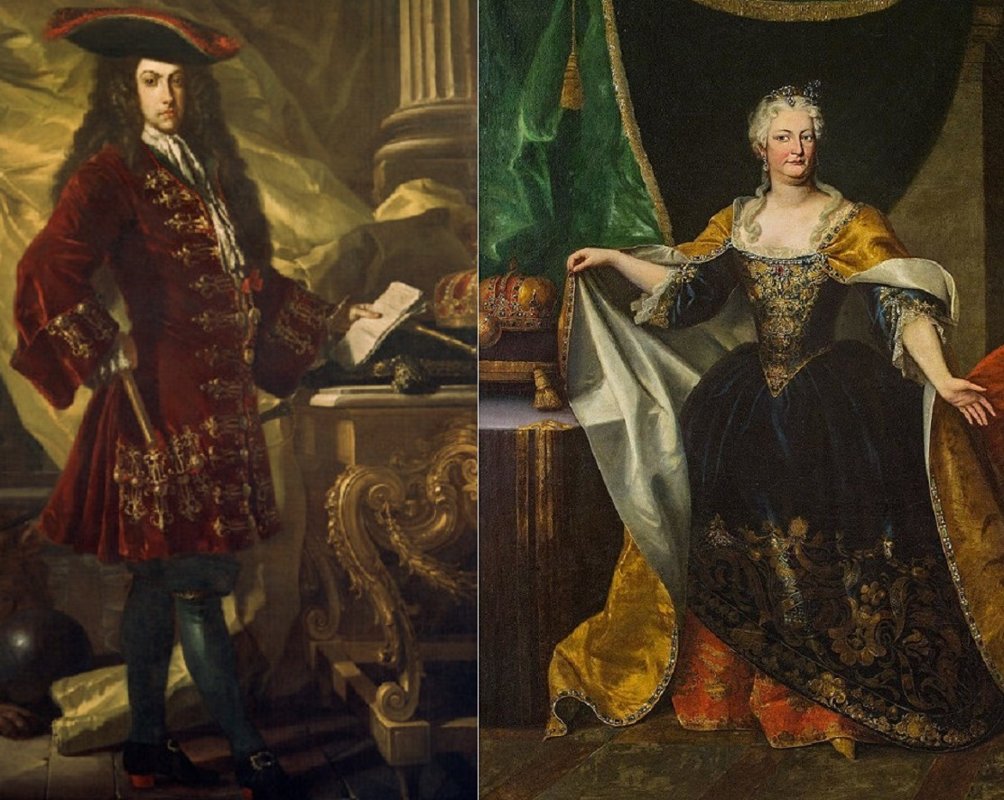 Maria Theresa was the eldest daughter of Holy Roman Emperor Charles VI (1685–1740) and his wife Elisabeth Christine of Brunswick-Wolfenbüttel,Germany (28 August 1691 – 21 December 1750) was Princess of Brunswick-Wolfenbüttel ,Holy Roman Empress, German Queen, Queen of Bohemia and Hungary; and Archduchess of Austria by her marriage to Emperor Charles VI.She was renowned for her delicate beauty and also for being the mother of Empress Maria Theresa. She was the longest serving Holy Roman Empress.
Maria Theresa was the eldest daughter of Holy Roman Emperor Charles VI (1685–1740) and his wife Elisabeth Christine of Brunswick-Wolfenbüttel,Germany (28 August 1691 – 21 December 1750) was Princess of Brunswick-Wolfenbüttel ,Holy Roman Empress, German Queen, Queen of Bohemia and Hungary; and Archduchess of Austria by her marriage to Emperor Charles VI.She was renowned for her delicate beauty and also for being the mother of Empress Maria Theresa. She was the longest serving Holy Roman Empress.
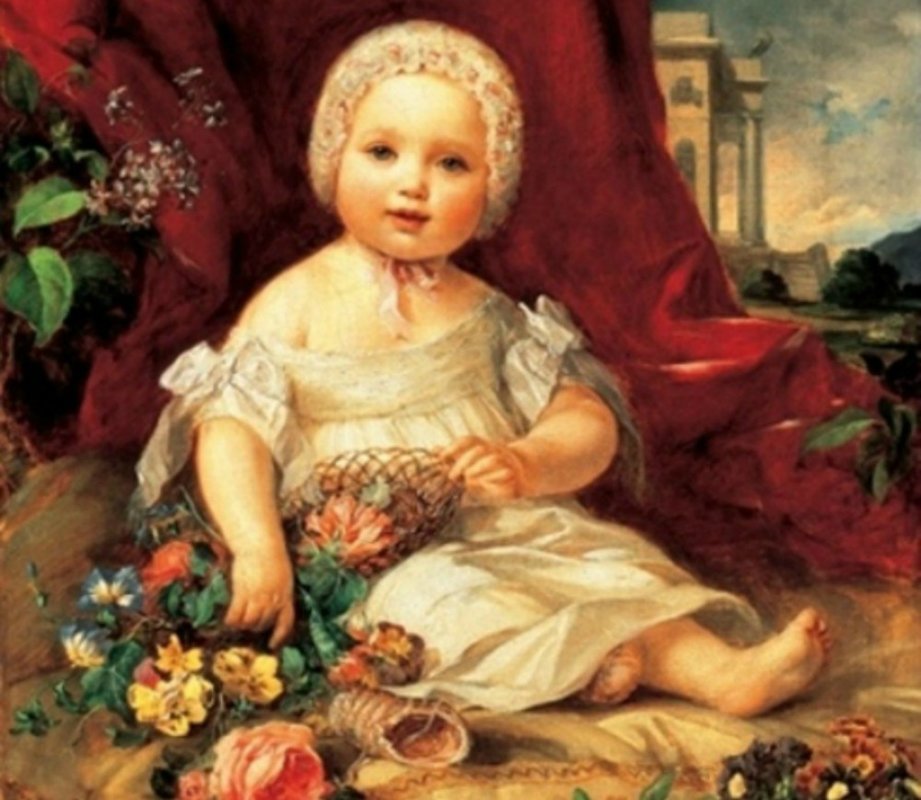 Maria Theresa's baby portrait,she
was only 14 years of age when her father allowed her to attend meetings
of the council, although he would never actually discuss the affairs of
state with her. Having spent his last years of life securing his
daughter’s inheritance, Charles Vl still
carried with him his disappointment of not having a son and failed to
prepare his daughter for the role of Sovereign, let alone one of a huge
empire.
Maria Theresa's baby portrait,she
was only 14 years of age when her father allowed her to attend meetings
of the council, although he would never actually discuss the affairs of
state with her. Having spent his last years of life securing his
daughter’s inheritance, Charles Vl still
carried with him his disappointment of not having a son and failed to
prepare his daughter for the role of Sovereign, let alone one of a huge
empire.
Maria Theresa, (born May 13, 1717, Vienna—died Nov. 29, 1780, in Vienna), archduchess of Austria and queen of Hungary and Bohemia (1740–80), wife and empress of the Holy Roman emperor Francis I (reigned 1745–65), and mother of the Holy Roman emperor Joseph II (reigned 1765–90). Upon her accession, the War of the Austrian Succession (1740–48) erupted, challenging her inheritance of the Habsburg lands. This contest with Prussia was followed by two more, the Seven Years’ War (1756–63) and the War of the Bavarian Succession (1778–79), which further checked Austrian power.The birth of Maria Theresa, full name Maria Theresia Walburga Amalia Christina, was a momentous occasion since her father, Charles VI, would ensure at great cost, that she would be heiress to the Habsburg realms from the moment she was born.Her father was the only surviving male member of the House of Habsburg and needed a son who would prevent the extinction of his dynasty and succeed him.The birth of Maria Theresa was said to be a great disappointment not only to him but the people of Vienna, a disappointment which he would personally never overcome.Reports which described her baptism, stressed that the child was carried ahead of her cousins, Maria Josepha and Maria Amalia, who were the daughters of her father’s elder brother Joseph 1, his predecessor. It was both a sign and unmistakable blatant show to others, to make it perfectly clear, that his daughter Maria Theresa would outrank them all.Their grandfather, Holy Roman Emperor Leopold I, had his sons sign the Mutual Pact of Succession, a remarkable agreement of that time which gave precedence to the daughters of the elder brother in succession, but this was a political move just to make sure that everybody knew what the situation was.Maria Theresa replaced Maria Josepha as heiress presumptive to the Habsburg realms the moment she was born, Charles VI had issued the Pragmatic Sanction of 1713 which had placed his own daughters ahead of his nieces in the line of succession.Charles VI was forced to seek the approval of other European powers in disinheriting his nieces for which they negotiated harsh terms in the 1731 Treaty of Vienna.One of the demands from Great Britain was that Austria abolish the Ostend Company. Formed in 1722, the private trading company operated the hugely profitable trade route with the East and West Indies and was a major competition for Great Britain. This was agreed to in return for its recognition of the Pragmatic Sanction. This expense show just how vital it was that Maria Theresa would be next in line to rule the empire of Charles Vl.Great Britain, France, Saxony-Poland, United Provinces, Spain, Venice, States of the Church, Prussia, Russia, Denmark, Savoy-Sardinia, Bavaria and the Diet of the Holy Roman Empire all recognised the sanction.France, Spain, Saxony-Poland, Bavaria and Prussia would all renege on the terms, which did not go down well with others. Such was the background of a childhood that would produce one of the most powerful women in Europe and therefore the world. Maria Teresa had big blue eyes, blond hair, a slight blush to the Goths, a wide mouth and a strong body, Moreover, thanks to the fact that parents do not have close family ties, Maria Teresa did not suffer the harmful effects of marriages between close blood relatives who had characterized many of his ancestors .Temperamentally, Maria Theresa was extremely serious and reserved; He loved to sing, archery and wanted to learn at least the basics of riding, but his father, fearing it could hurt, prevented it, also he participated in opera productions, often conducted directly by the Emperor Charles VI.His education was supervised by the Jesuits who, although were able to teach her a good Latin, they were unable to correct his spelling and punctuation unconventional nor transmitted the eloquence of his predecessors to the point that the same Maria Teresa became used to talk and writing in Viennese dialect. The father, who still awaited male heir, not instructed on the affairs of state nor gave to his daughter preparing a heir to the throne, although allowed to sit on the board since he was fourteen years for this reason, in fact, Maria Teresa, like the younger sister, received only notions of drawing, painting, music and dance disciplines for a typical role of a princess or a queen consort.In Austria, the Empress Maria Theresa was much loved by the people, and they tell many funny episodes about her. On one occasion he spank a naughty boy who climbed on scaffolding so reckless, risk breaking his neck. That boy later became the great composer Franz Joseph Haydn, and had occasion to recall that episode to the Empress, who was pleased with herself for having perhaps saved the life of a musician like him. On another occasion, already elderly, she interrupted a performance at the Burgtheater in rushing imperial stage to announce to the audience, speaking in Viennese dialect, the birth of a grandson (son of the Grand Duke of Tuscany P.Leopold).Despite being greased, Maria Teresa was in excellent health, and even in winter he always kept the windows open. He ran personally to close them when he was to receive his minister Kaunitz, who instead was a patch hypochondriac and was always complaining of a thousand ills. The Empress was famous because she was seen in public, in a carriage, even a few hours after giving birth.
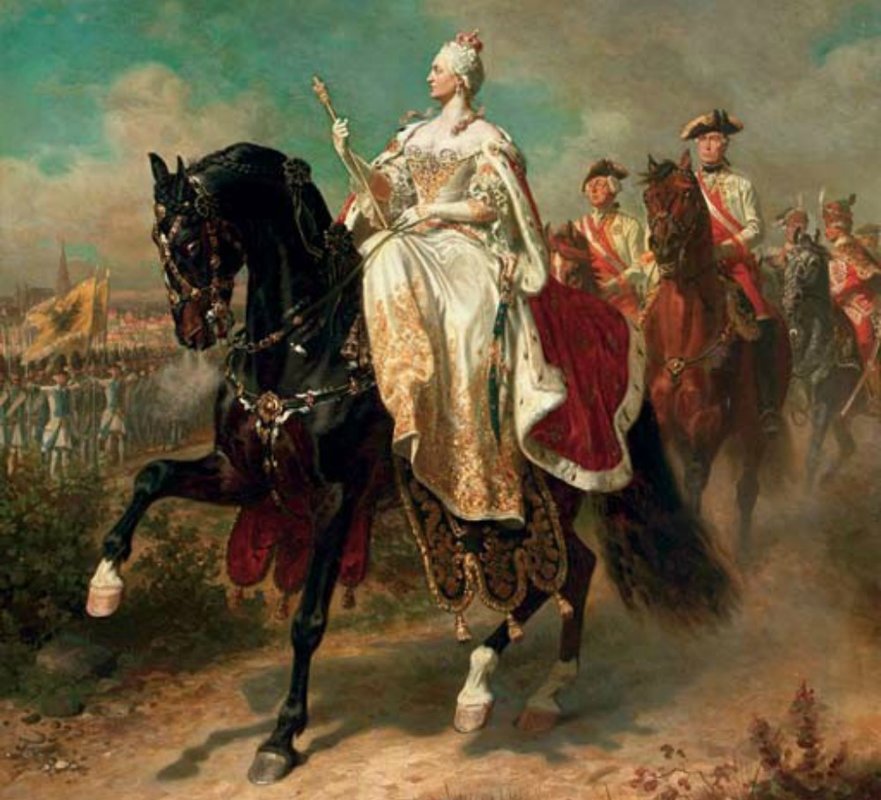 Since Charles had no male heirs, one of his chief concerns was to secure the succession to the Hapsburg lands for his daughter, Maria Theresa . His last years were spent in an effort to win European approval of the pragmatic sanction of 1713, which made Maria Theresa his heir. Although the Pragmatic Sanction was guaranteed by the Treaty of Vienna, the succession was contested on his death . Charles was a patron of learning and the arts, particularly of music. A mercantilist, he encouraged commerce and industry.Maria Theresa loved the arts from an early age and was well educated in painting, drawing, dancing and music. These were the main requirements for any woman of the age preparing for the role of Queen-Consort.
Since Charles had no male heirs, one of his chief concerns was to secure the succession to the Hapsburg lands for his daughter, Maria Theresa . His last years were spent in an effort to win European approval of the pragmatic sanction of 1713, which made Maria Theresa his heir. Although the Pragmatic Sanction was guaranteed by the Treaty of Vienna, the succession was contested on his death . Charles was a patron of learning and the arts, particularly of music. A mercantilist, he encouraged commerce and industry.Maria Theresa loved the arts from an early age and was well educated in painting, drawing, dancing and music. These were the main requirements for any woman of the age preparing for the role of Queen-Consort.
Her father was Charles VI, emperor of the vast Habsburg lands that stretched from the royal capital of Vienna to the Netherlands in the north, Sicily in the south, and colonies in the Americas and Africa. When Charles was initially childless in his marriage to the euphoniously named Elisabeth Christine of Braunschweig-Wolfenbüttel, he declared that the daughters of royal princes could succeed the Habsburg throne, broadening the path to rule.But four children of his own did eventually come along, and the two that survived were both female. Maria Theresa was the oldest.The throne was hers, but before she could settle into it she had to fight an eight-year war of succession with France, Prussia, and other Habsburg states that refused to acknowledge her rule. Even after she won, she was never officially given the title of empress.“I found myself without money, without credit, without army, without experience and knowledge of my own, and finally also without any counsel because each one of them at first wanted to wait and see how things would develop,” she wrote in her autobiography. Her husband Franz became her stand-in, and everyone seemed happy with this insincere acquiescence to sexual politics (he wasn’t even Habsburgian)–perhaps even Maria Theresa, who was still pulling the strings and had probably gotten tired of Franz lying around anyway.She wasn’t much for idleness among the idle rich. Once a week, she wrote to each of her 13 surviving children (11 are depicted in the painting at top), critiquing their public appearances, their religious devotion, and their studies. She was preparing them, like any mom would, for their future: pawns of European politics, married off to one noble or another in order to secure an alliance. Four of her daughters became duchesses or queens, most famously Marie Antoinette, who married King Louis XVI of France at 14 and was beheaded in the French Revolution.When her own husband died, Maria Theresa appointed her son Joseph II as emperor but ruled alongside him. She wanted to set an example, abolishing serfdom and providing universal schooling, and when her son objected, she sidelined him. A mother’s love only goes so far.Her father banned her from horse
riding, thought to be due to the risks involved, it was however only
realistic to protect her after all the political manoeuvring that had
undergone since her birth. She would later take intense lessons in
preparation for her Hungarian coronation ceremony. She would be crowned KING of Hungary as women were not considered fit to rule Hungary.Her family would stage opera productions in their palaces, often conducted by her father Charles Vl, in which she immersed herself and relished every moment.She was educated under the
guidance of the Jesuit priests, which was strict in accordance with the
church, but it was said that they failed to educate her to the level
expected, with her spelling and punctuation being termed unconventional.
Her Latin was said to be good, but that would be the end of positive
comments. She lacked the formal manner and speech which had been so
important and had characterized her Habsburg predecessors. It was largely thanks to Countess Marie Karoline Von Fuchs-Mollard , with whom she had formed a close personal relationship that her understanding of etiquette would flourish.However, her deep-seated
and sincere interest in politics and her people, set her apart from
other female royals and would go a long way to making her such a
powerhouse.The question of Maria Theresa's marriage was raised early in her childhood. She would be first engaged to marry Leopold Clement of Lorraine, who was supposed to visit Vienna to meet the Archduchess in 1723 when she was just 6 years old. However, he died of smallpox before they would ever meet. Shortly after the death of Leopold Clement, his younger brother, Francis Stephen, was invited to Vienna. Francis Stephen had been the favourite for Maria Theresa's
hand but her father had to consider other possibilities. Religious
differences prevented him from arranging his daughter's marriage to the
Calvinist prince Frederick of Prussia, later to be known as Frederick The Great.Following battle victories during the 7 year war.In 1725, she was betrothed to Charles of Spain and her sister, Maria Anna, to Philip of Spain. However, he was forced to renounce the pact by other European powers.The pact, which had been made with the Dowager Queen of Spain, Elisabeth Farnese, would have resulted in the marriage of heirs to the thrones of Spain and Austria destroying the European balance of power.Maria Theresa, who had become close to Francis Stephen, was relieved. Although Francis Stephen would remain at the Imperial Court until 1729, when he ascended the throne of Lorraine. He would only be formally accepted as suitor for Maria Theresa's hand on 31 January 1736 but the couple would marry on February 12th 1736.During the war, Louis XV of France demanded that Francis Stephen, Maria Theresa’s fiancé, surrender his ancestral Duchy of Lorraine in order to support his own father-in-law who was none other than Stanslaw l and who had been deposed as King of Poland. In return, Francis Stephen would receive the Grand Duchy of Tuscany upon the death of the Grand Duke Gian Gastone de Medici, who was without heir. The war ended with the Treaty of Vienna in 1738, and an estimated 100,000 dead and wounded. Augustus lll was confirmed as King of Poland and his opponent Stanislaw l was awarded the Duchy of Lorraine. The Duchy of Parma went to Austria while the crowns of Naples and Sicily would go to Charles of Parma, all resulting in territorial gains for the Bourbons.Gian Gastone's death on 9 July 1737 (the end of the Medici dynasty) meant that Francis Stephen ceded Lorraine and became Grand Duke of Tuscany.In 1738, Charles VI arranged for the Maria Theresa and Francis Stephen to make their formal entry into Florence, the regional capital of Tuscany where a triumphal arch was erected at the Porta Galla in celebration. Their time in Florence would be short-lived as Charles Vl feared of dying whilst his heiress was in Florence.In 1738 Austria suffered humiliating defeats during the Russo-Turkish war, where the Turks had reversed earlier Austrian gains in Serbia, Wallachia and Bosnia, having entered the war in 1737 which Russia had been fighting since 1735.Riots ensued across Vienna at the cost of the war, together with open hostility and hatred towards Francis Stephen who was seen as a cowardly French spy. The war was ended the following year with the treaty of Belgrade.
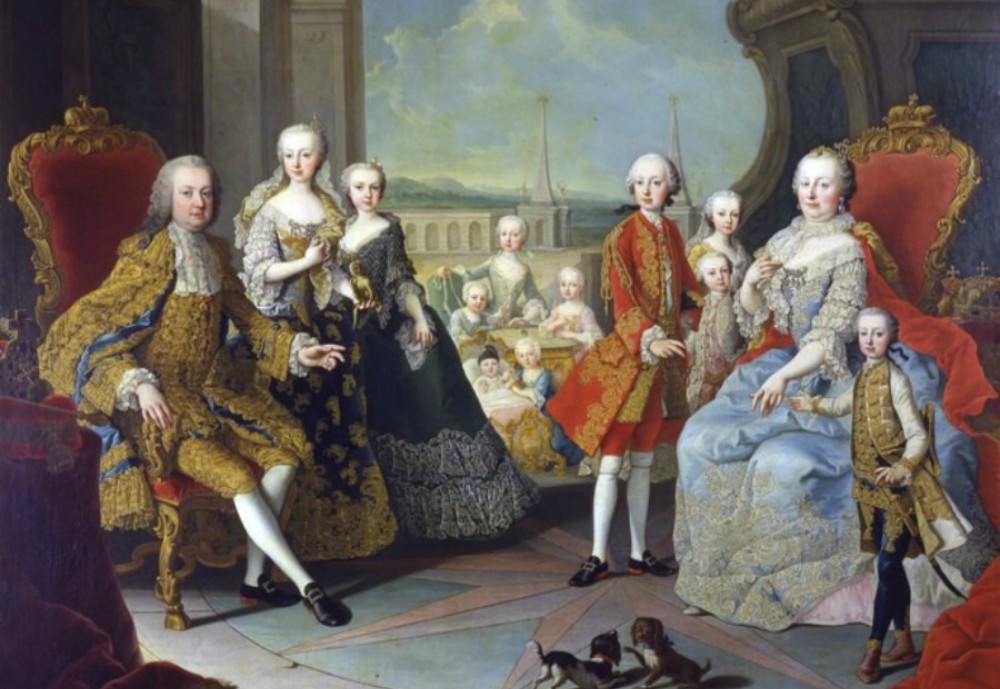 Maria Theresa and Her Family on the Terrace of Schönbrunn Palace (c. 1755).Maria Theresia was married to Francis Stephen, son of the Duke of
Lorraine. They founded the new dynasty of Habsburg-Lorraine. Maria
Theresa was the only ruling female of the Habsburg dynasty, which ruled
great parts of Europe during 650 years.The marriage of Maria
Theresa and Fransic I was also arranged by Charles VI, and for that
reason Francis grew up in Vienna together with Maria Theresa. Unlike
many arranged marriages their’s was one of love and affection. They had
sixteen children together. Maria Theresa made sure her children had good marriages in order to make allies throughout Europe.Below you will find a list of of all their surviving children and their spouses.Maria Theresa children from the right:
Archduchess Maria Amalia of Austria, Archduchess Maria Anna of Austria,
Archduchess Maria Johanna Gabriela of Austria, Archduchess Maria
Josepha of Austria, Archduke Ferdinand of Austria-Este, Duchess of
Teschen, Duke of Breisgau, Holy Roman Emperor, Joseph II, Leopold II,
Maria Carolina of Austria, Maria Christina, Marie Antoinette.
Maria Theresa and Her Family on the Terrace of Schönbrunn Palace (c. 1755).Maria Theresia was married to Francis Stephen, son of the Duke of
Lorraine. They founded the new dynasty of Habsburg-Lorraine. Maria
Theresa was the only ruling female of the Habsburg dynasty, which ruled
great parts of Europe during 650 years.The marriage of Maria
Theresa and Fransic I was also arranged by Charles VI, and for that
reason Francis grew up in Vienna together with Maria Theresa. Unlike
many arranged marriages their’s was one of love and affection. They had
sixteen children together. Maria Theresa made sure her children had good marriages in order to make allies throughout Europe.Below you will find a list of of all their surviving children and their spouses.Maria Theresa children from the right:
Archduchess Maria Amalia of Austria, Archduchess Maria Anna of Austria,
Archduchess Maria Johanna Gabriela of Austria, Archduchess Maria
Josepha of Austria, Archduke Ferdinand of Austria-Este, Duchess of
Teschen, Duke of Breisgau, Holy Roman Emperor, Joseph II, Leopold II,
Maria Carolina of Austria, Maria Christina, Marie Antoinette.
Maria Theresa the Duchess of Lorraine, held true love for her husband which was described as being strong and possessive. Letters she had sent him just before their marriage, expressed her eagerness to see him. On the other hand, his letters were cold and formal. She was known to be extremely jealous of her husband and his infidelity, which would go on to become the greatest problem of their marriage. Maria Wilhelmina von Neipperg, later to become Princess of Auersperg, would become his best known mistress after making her appearance in court in 1755 at the age of 17.Emperor Charles VI died on October 20 1740, most probably of mushroom poisoning. The advice of Prince Eugene of Savoy to concentrate on filling the treasury and equipping the military was ignored. Instead, Charles Vl gave more credence to gathering the support of fellow royals and making various pacts with no financial gain. He had spent virtually his entire reign securing the Pragmatic Sanction in order for Maria Theresa to succeed him, but had left Austria an impoverished nation. Bankrupted by the recent Turkish war and the earlier ware of the polish succession, the treasury held just 100,000 florins which was claimed by his widow. An 80,000 army, unpaid for months, remained impressively loyal and devoted to their new Sovereign.Archduchess Maria Anna was the oldest daughter of Maria Theresa and Francis.She was physically disabled, and therefore never married and had no issue. She was very intelligent and had a great interest in art and science.She became abbess in 1766 and spend the last years of her life living together with her sister Maria Elisabeth.Archduke Josep married Princess Isaballa in 1760.Joseph really loved his first wife. She had more feelings for her sister-in-law, Archduchess Maria Christina with whom she spend almost all of her time. Isabella had several miscarriages, and her only surviving daughter Archduchess Maria Theresa of Austria, died in 1770 at the age of eight from pneumonia. Isabella died even before that in 1763 from smallpox.Since Joseph’s first marriage did not produce an heir to the throne he was forced by his mother, Empress Maria Theresa, to remarry.The wife she choose for him was Maria Josepha of Bavaria, his second cousin. The marriage was not a happy one, and lasted only for two years. In 1767 she also died from smallpox, just like Joseph’s first wife. Joseph did not visit her when she was ill, and did not even show up for her burial. He never re-married and had no surviving issue.Joseph II died in 1790 and was succeeded by his brother, Leopold II.Archduchess Maria Christina was the only of Maria Theresa's daughters who was allowed to choose her own husband. The couple had a happy marriage. They only had one daughter who died a day after her birth. Maria christiana was not able to have any more children after that. They adopted Archduke Charles of Austria, the son of maria Christina's brother Leopold. Archduchess Maria Elisabeth was said to be the most beautiful daughter of Maria Theresa and her mother hoped for a good marriage for her.She was even considered to be the second wife of Louis XV when his first wife died in 1768. But then Maria Elisabeth also contacted smallpox which scarred her face in such a way that her changes of a good wedding were over.She became an abbess of the Convent for Noble Ladies just like her older sister Archduchess Maria Anna with whom she spend her last years.Archduke Karl Josef was the second and favourite son of Maria Theresa.He hated his older brother Joseph and claimed he had more right to the throne than his elder brother since he was the first born while his fatherwas Emperor (which was not true since his father became emperor in October 1745 while he was born in February). He was bound to cause trouble, but before things could get out of hand he too died from smallpox just before he turned sixteen.His mother was in tears, but he would have said: "You should not weep for me, dear mother, for had I lived, I would have brought you many more tea.Archduchess Maria Amalia was married to Ferdinand, the Duke of Parma (the brother of Archduke Joseph’s first wife Princess Isabella of Parma). This marriage was not her own choice, but her mother’s. Maria Amalia resented her mother for the fact that her sister Maria Christina was allowed to marry the man of her choice, and she was not. The relationship between mother and daughter never improved.Maria Amalia was almost as fertile as her mother. She gave birth to 9 children. Most of her children died young; 2 died in infancy and at the age of 46 she gave birth to a stillborn twin. Only three of her children grew up to adulthood. The two daughters joined a religious order and had no issue. The oldest son became King Louis I of Etruria.Another fruitfull marriage was that of Archduke Peter Leopold with the Infanta Maria Luisa of Spain. Like his parents he too had sixteen children (and a lot of illegitimate children as Leopold was famous for his affaires). As Leopold (as anyone called him) was the third son it was unlikely for him to ever become emperor, or even Duke of Tuscany, since those titles (both held by his father Francis I) were reserved for his older brothers. When his brother Charles died in 1761 it was decided that Leoppold should succeed his father as Grandduke of Tuscany. There was even a change of bride at that moment; until then Leopold was engaged to be married to Maria Beatrice d'Este, heiress to the Duchy of Modena. After his Charles' dead this engagement was broken off so he could marry a better spouse (Maria Beatrice married his brother Archduke Ferdinand instead!)Leopold and Maria Luisa were married 1764 and spend the first twenty years in Florence as the Grand Duke and duchess of Tuscany, and than, in 1790, Emperor Josef II died. They became holy roman emperor and empress and went back to Vienna. Their second son Fredinand succeeded his father as Grand Duke of Tuscany, while his older brother Francis had to wait untill his father's dead before he could succeed him. This would not take long however, since Emperor Leopold II died two years after his coronation, and his wife died three months later. Archduchess Maria Johanna Gabriela was engaged to Ferdinand I of the Two Sicilies. In the second half of the eighteenth century smallpox was cause of death for many people in Austria. Maria Theresa desided to inoculate all her children to set an example to the common people.All children suvived this primitive immunization, except Maria Johanna. She died of small pox at the age of 12.Archduchess Maria Josepha was also engaged to Ferdinand I of the Two Sicilies. On the very day she was to travel to her fiancee to get married, she too died of smallpox. She was sixteen years old. Archduchess Maria Carolina was the one who finally married Ferdinand I of the two Sicilies, who had been engaged too two of her sisters first. They had 18 children, from which 11 died in childhood. She tried to marry the surviving children off as strategically as her mother had done with her children.King Ferdinand I of the Two Sicilies is also known as Ferdinand III of Sicily and Ferdinand IV of Naples. In 1816 both thrones were merged and he became King Ferdinand I of the Two Sicilies. Maria Theresa arragenged good marriages not only for her daughters. The brides for her sons were also picked strategically. By the marriage of Ferdinand with Maria Beatrice d'Este the Duchy of Modena (in Italy) became part of the Habsburg empire.The couple had ten children. Their youngest daughter Maria Louise later married her first cousin, emperor Francis I of Austria, the son of Leopold II.The later Queen of France Marie Antoinette was born as Maria Antonia in Austria on 2 November 1755.When she left her home in Vienna on April 21, 1770 for the last time, she had a journey of 23 days ahead of her. She was just 15 years old and had never met her fiancée, Louis Auguste, the Dauphin of France. He was only 16 years old at the time.All he had seen of his wife to be is a portrait. Here you can sse the presentation of Maria Antonia portrait at the court of Versailles. Both King Louis XV and his grandson, as well as the other members of the royal family are curious, and happy with what they see.But even if they would have been disappointed with the looks of Marie Antonia, this was not important since the marriage was necessary to improve the relations between France and Austria.Maria Antonia Josepha Johanna was born on 2 November 1755 as the youngest daughter of Emperor Francis I and Empress Maria Theresa.She was one of 16 children who grew up at the Hofburg Palace in Vienna. She had a carefree childhood with her siblings with whom she was very close, especially with her sister Maria Carolina who was around the same age.Marie Antoinette’s mother, the Empress Marie Theresia loved her children and treated them with affection, making it a habit to write them once a week after they left the Hofburg.Nevertheless she also used them in her political strategies to make allies throughout Europe, even against the wishes of some of the children. Her favourite daughter, Maria Christina, who was 13 years older than Maria Antonia, was the only one who was allowed to choose her own husband. The other children were send off to marry someone they had never met. This was the same for Maria Antonia, who left Austria at the age of 15, and would never come back or see her mother again.Archduke Maximilian Franz became Archbishop-Elector of Cologne and Prince-Bishopric of Münster.Maximilian Francis is best known as the patron of Ludwig van Beethoven. He was a great supporter of the arts, and maintained a court orchestra, which was very fashionable at the time.Ludwig's father, Johann van Beethoven, was tenor in this orchestra at the Court of the elector in Bonn. Maximilian soon discovered the talent of the young Ludwig and made sure that he could go to Vienna to study with Mozart.Maximilian never had a good health and became very fat. He died at the early age of 45.
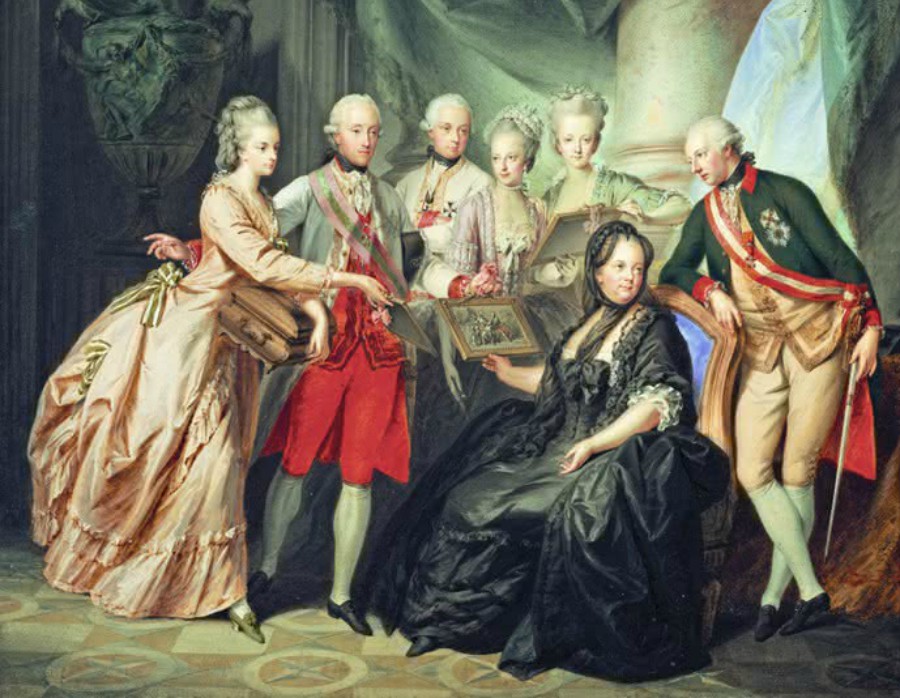 Theresa gave birth to 16 children. However, only 13 of her children survived infancy. As a member of the House of Habsburg, Maria Theresa's relatives are found in nearly every European royal court.Following family tradition, all of Maria's daughters were given the name 'Maria'. In 1770, Maria married her youngest daughter, Maria Antonia, to Louis, the future king of France. Changing her name to Marie Antoinette, the young queen would serve a memorable role in the French Revolution.
Theresa gave birth to 16 children. However, only 13 of her children survived infancy. As a member of the House of Habsburg, Maria Theresa's relatives are found in nearly every European royal court.Following family tradition, all of Maria's daughters were given the name 'Maria'. In 1770, Maria married her youngest daughter, Maria Antonia, to Louis, the future king of France. Changing her name to Marie Antoinette, the young queen would serve a memorable role in the French Revolution.
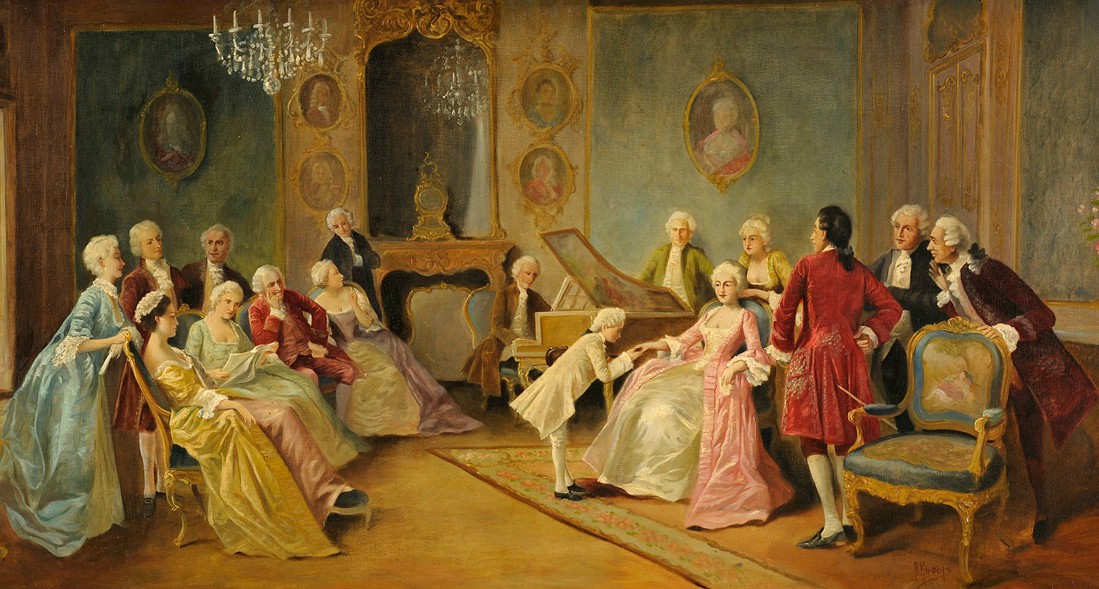 The Mozart family grand tour was a journey through western Europe, undertaken by Leopold Mozart, his wife Anna Maria, and their musically gifted children Maria Anna (Nannerl) and Wolfgang Amadeus from 1763 to 1766. At the start of the tour the children were aged eleven and seven respectively. Their extraordinary skills had been demonstrated during a visit to Vienna in 1762, when they had played before the Empress Maria Theresa at the Imperial Court.
The Mozart family grand tour was a journey through western Europe, undertaken by Leopold Mozart, his wife Anna Maria, and their musically gifted children Maria Anna (Nannerl) and Wolfgang Amadeus from 1763 to 1766. At the start of the tour the children were aged eleven and seven respectively. Their extraordinary skills had been demonstrated during a visit to Vienna in 1762, when they had played before the Empress Maria Theresa at the Imperial Court.
As the eldest surviving child of the Holy Roman Emperor Charles VI, Maria was not originally expected to ever inherit her father's throne. But when her father failed to produce any male children, Maria was formally trained in statecraft and the arts of governance. When her prospective groom, Leopold Clement, died from an illness, she eventually married his younger brother. After Maria's father died, several neighboring kings took the opportunity to invade her lands. Although she started off with a depleted treasury and limited leadership experience, Maria Theresa soon proved her mettle by doubling the empire's income and raising a large standing army The War of the Fifth Coalition was fought in 1809 by a coalition of the Austrian Empire and the United Kingdom against Napoleon's French Empire and Bavaria. Major engagements between France and Austria, the main participants, unfolded over much of Central Europe from April to July, with very high casualty rates for both sides. Britain, already involved on the European continent in the ongoing Peninsular War, sent another expedition, the Walcheren Campaign, to the Netherlands in order to relieve the Austrians, although this effort had little impact on the outcome of the conflict. After much campaigning in Bavaria and across the Danube valley, the war ended favourably for the French after the bloody struggle at Wagram in early July.The resulting Treaty of Schönbrunn was the harshest that France had imposed on Austria in recent memory. Metternich and Archduke Charles had the preservation of the Habsburg Empire as their fundamental goal, and to this end the former succeeded in making Napoleon seek more modest goals in return for promises of Franco-Austrian peace and friendship. Nevertheless, while most of the hereditary lands remained part of Habsburg territories, France received Carinthia, Carniola, and the Adriatic ports, while Galicia was given to the Poles and the Salzburg area of the Tyrol went to the Bavarians. Austria lost over three million subjects, about one-fifth of her total population, as a result of these territorial changes.Although the Fifth Coalition ended, Britain, Spain and Portugal remained at war with France in the ongoing Peninsular War. There was peace in central and eastern Europe until Napoleon's invasion of Russia in 1812, which led to the formation of the Sixth Coalition in 1813.The end of the War of the Fifth Coalition resulted in the marriage of Napoleon and Marie Louise in 1810, which ushered in a brief period of peace and friendship between Austria and the French Empire. Footnote: Marie Louise (Maria Ludovica Leopoldina Franziska Therese Josepha Lucia; Italian: Maria Luigia Leopoldina Francesca Teresa Giuseppa Lucia; December 12, 1791 - December 17, 1847) was an Austrian archduchess who reigned as Duchess of Parma from 1814 until her death. She was Napoleon's second wife and, as such, Empress of the French from 1810 to 1814. As the eldest child of the Habsburg Emperor Francis II of Austria and his second wife, Maria Theresa of Naples and Sicily, Marie Louise grew up during a period of continuous conflict between Austria and revolutionary France. A series of military defeats at the hands of Napoleon Bonaparte had inflicted a heavy human toll on Austria and led Francis to dissolve the Holy Roman Empire. The end of the War of the Fifth Coalition resulted in the marriage of Napoleon and Marie Louise in 1810, which ushered in a brief period of peace and friendship between Austria and the French Empire. Marie Louise dutifully agreed to the marriage despite being raised to despise France. She was an obedient wife and was adored by Napoleon, who had been eager to marry a member of one of Europe's leading royal houses to cement his relatively young Empire. With Napoleon, she bore a son, styled the King of Rome at birth, later Duke of Reichstadt, who briefly succeeded him as Napoleon II. Napoleon's fortunes changed dramatically in 1812 after his failed invasion of Russia. The European powers, including Austria, resumed hostilities towards France in the War of the Sixth Coalition, which ended with the abdication of Napoleon and his exile to Elba. The 1814 Treaty of Fontainebleau handed over the Duchies of Parma, Piacenza and Guastalla to Empress Marie Louise. She would come to rule the duchies until her death. In the summer of 1814, Emperor Francis sent Count Adam Albert von Neipperg to accompany Marie Louise to the spa town of Aix-les-Bains, to prevent her from joining Napoleon on Elba. Neipperg was a confidant of Count Metternich and an enemy of Napoleon. Marie Louise fell in love with Neipperg. He became her chamberlain and her advocate at the Congress of Vienna. News of the relationship was not received well by the French and the Austrian public. When Napoleon escaped in March 1815 and reinstated his rule, the Allies once again declared war. Marie Louise was asked by her stepmother to join in the processions to pray for the success of the Austrian armies but rejected the insulting invitation. She passed a message to Napoleon's private secretary, Claude François de Méneval, who was about to return to France: "I hope he will understand the misery of my position .I shall never assent to a divorce, but I flatter myself that he will not oppose an amicable separation, and that he will not bear any ill feeling towards me .This separation has become imperative; it will in no way affect the feelings of esteem and gratitude that I preserve." Napoleon was defeated for the last time at the Battle of Waterloo and was exiled to Saint Helena from October 1815. Napoleon made no further attempt to contact her personally. The Congress of Vienna recognized Marie Louise as ruler of Parma, Piacenza, and Guastalla, but prevented her from bringing her son to Italy. It also made her Duchess of Parma for her life only, as the Allies did not want a descendant of Napoleon to have a hereditary claim over Parma. Marie Louise departed for Parma on March 7, 1816, accompanied by Count Adam Albert von Neipperg. She entered the duchy on April 18th, later writing to her father: "People welcomed me with such enthusiasm that I had tears in my eyes." She largely left the running of day-to-day affairs to Neipperg, who received instructions from Metternich. In December 1816, Marie Louise removed the incumbent prime minister and installed Neipperg. She and Neipperg had three children: Albertine, Countess of Montenuovo (1817-1867), who married Luigi Sanvitale, Count of Fontanellato; William Albert, Count of Montenuovo, who later created Prince of Montenuovo (1819-1895) and married Countess Juliana Batthyány von Németújvár; and Mathilde, Countess of Montenuovo (1822-c.1823). Napoleon died on May 5, 1821. Three months later, on August 8th, Marie Louise married Neipperg morganatically (defined as a marriage between a member of a royal or noble family and a person of inferior rank, in which the rank of the inferior partner remains unchanged and the children of the marriage do not succeed to the titles, fiefs, or entailed property of the parent of higher rank), her second marriage. Neipperg died of heart problems on February 22, 1829, devastating Marie Louise. She was banned by Austria from mourning in public. Her first son, then known as "Franz," was given the title Duke of Reichstadt in 1818. Franz lived at the Austrian court, where he was shown great affection by his grandfather, but was constantly undermined by Austrian ministers and nationalists, who did their best to sideline him to become an irrelevance. Franz grew resentful at his Austrian relatives and his mother for their lack of support, and began identifying as Napoleon II. and surrounding himself with French courtiers. The relationship with his mother broke down to such an extent that he once remarked "If Josephine had been my mother, my father would not have been buried at Saint Helena, and I should not be at Vienna. My mother is kind but weak; she was not the wife my father deserved; Josephine was." However, before anything could become of Napoleon II, he died at the age of 21 in Vienna in 1832, after suffering from tuberculosis. The year 1831 saw the outbreak of the Carbonari-led uprisings in Italy. In Parma, protesters gathered in the streets to denounce the Austrian-appointed prime minister Josef von Werklein. Marie Louise did not know what to do and wanted to leave the city, but was prevented from doing so by the protesters, who saw her as someone who would listen to their demands. She managed to leave Parma between February 14th and 15th, and a provisional government, led by Count Filippo Luigi Linati, was formed. At Piacenza, she wrote to her father, asking him to replace Werklein. Francis sent in Austrian troops, which crushed the rebellion. To avoid further turmoil, Marie Louise granted amnesty to the dissidents on September 29th. Metternich sent Count Charles-René de Bombelles to Marie Louise's household in 1833, as her chamberlain. Six months after his arrival, on February 17, 1834, she married him, again morganatically. She would continue to reign for almost another fourteen years. Marie Louise fell ill on December 9, 1847 and her condition worsened over the next few days. On December 17th, she passed out after vomiting and never woke up again. She died that evening, five days after her 56th birthday, the cause of death determined to be pleurisy (inflammation of the pleurae, which impairs their lubricating function and causes pain when breathing, caused by pneumonia and other diseases of the chest or abdomen). Her body was transferred back to Vienna and buried at the Imperial Crypt.After a series of disastrous wars destroyed half of Europe, Maria found that her empire had emerged relatively unscathed. Using her intellect and education, Maria initiated a renaissance in her empire and implemented several important educational and judicial reforms. After successfully marrying off her surviving children to the royal houses of Europe, Maria Theresa died peacefully in her bed, one of the most powerful female monarchs of the early modern era.
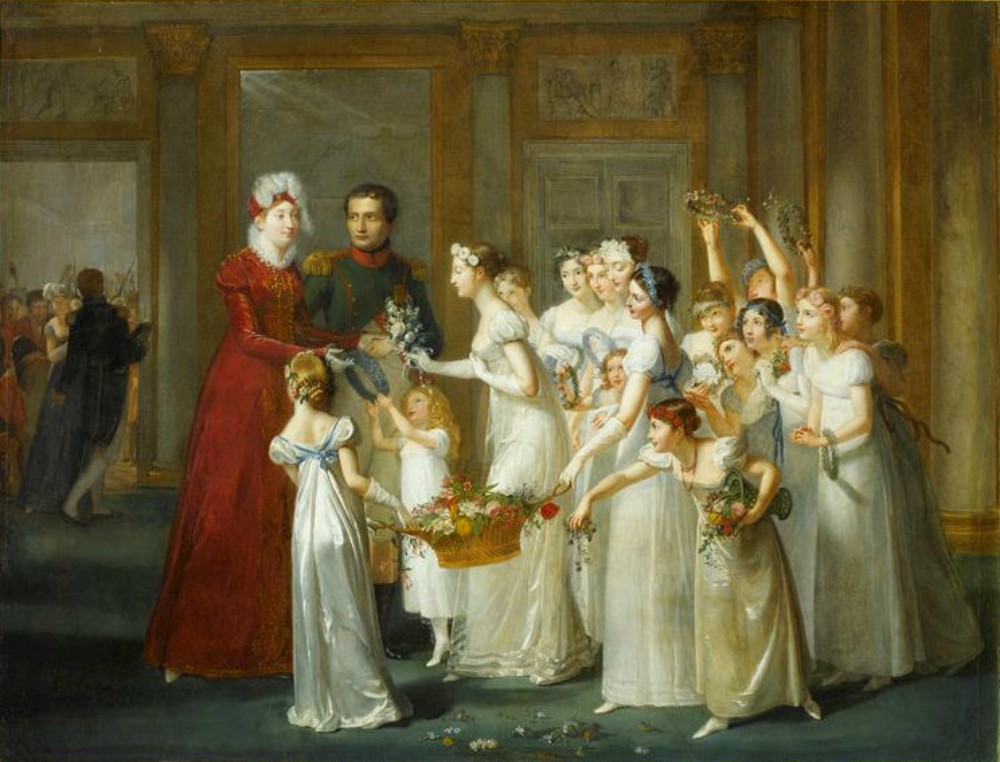
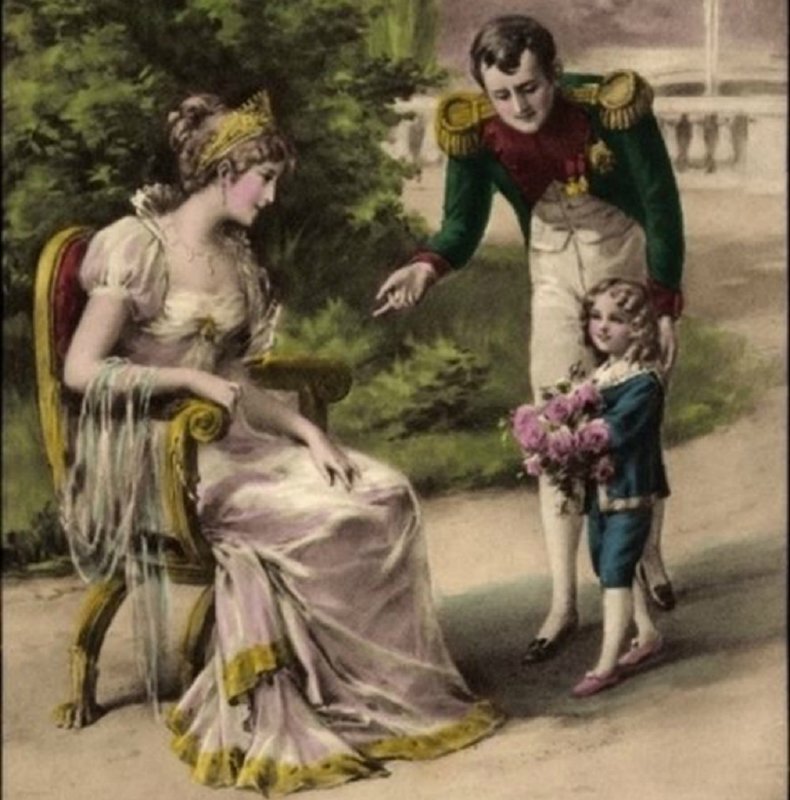 The end of the War of the Fifth Coalition resulted in the marriage of Napoleon and Marie Louise in 1810.In December 1809 Napoleon ended his marriage to his first wife Josephine because she could not provide him with an heir.Marie Louise grew up during a period of continuous conflict between Austria and revolutionary France.As the eldest child of the Habsburg Emperor Francis II of Austria and his second wife, Maria Theresa.Marie Louise was not keen on the idea. She had never met Napoleon.They were married in a religious ceremony on March 11, 1810,they had a son.
The end of the War of the Fifth Coalition resulted in the marriage of Napoleon and Marie Louise in 1810.In December 1809 Napoleon ended his marriage to his first wife Josephine because she could not provide him with an heir.Marie Louise grew up during a period of continuous conflict between Austria and revolutionary France.As the eldest child of the Habsburg Emperor Francis II of Austria and his second wife, Maria Theresa.Marie Louise was not keen on the idea. She had never met Napoleon.They were married in a religious ceremony on March 11, 1810,they had a son.
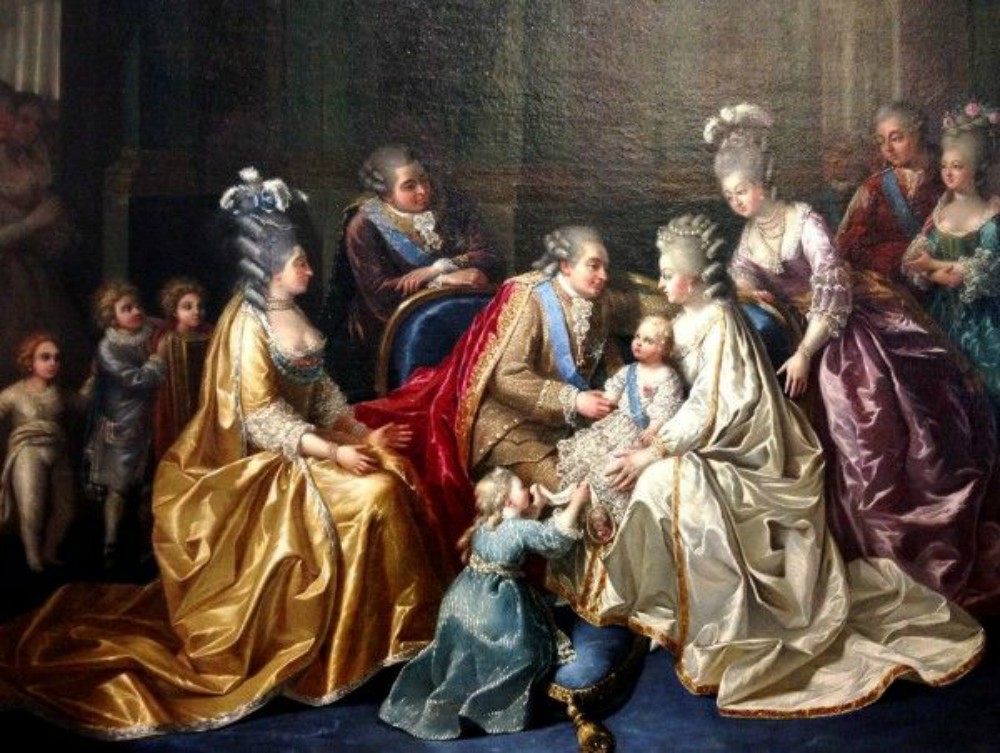 Marie Antoinette was born in Vienna, Austria, in 1755, Archduchess Marie Antoinette was the
15th and last child of Holy Roman Emperor Francis I and the powerful
Habsburg Empress Maria Theresa.She was only 14 years old when she married the future Louis XVI.To seal the newfound alliance between longtime enemies Austria and
France that had been forged by the Seven Years’ War, the Austrian
monarchs offered the hand of their youngest daughter to the heir
apparent to the French throne, Dauphin Louis-Auguste. On May 7, 1770,
the 14-year-old royal bride was delivered to the French on an island in
the middle of the Rhine River, and a grand procession escorted the
archduchess to the Palace of Versailles. The day after Marie Antoinette
met the 15-year-old future king of France, the two were wed in a lavish
palace ceremony.On the morning of October 16, 1793, Henri Sanson entered the prison cell
housing Marie Antoinette, the 37-year-old former queen of France who
only hours before had been convicted of treason and sentenced to death.
The red-hooded executioner sheared Marie Antoinette’s beloved locks to
allow for a quick, clean cut of his guillotine blade. Moments after
cutting her hair, Sanson cut off her head as a joyous crowd cheered,
“Vive la nation!”
Marie Antoinette was born in Vienna, Austria, in 1755, Archduchess Marie Antoinette was the
15th and last child of Holy Roman Emperor Francis I and the powerful
Habsburg Empress Maria Theresa.She was only 14 years old when she married the future Louis XVI.To seal the newfound alliance between longtime enemies Austria and
France that had been forged by the Seven Years’ War, the Austrian
monarchs offered the hand of their youngest daughter to the heir
apparent to the French throne, Dauphin Louis-Auguste. On May 7, 1770,
the 14-year-old royal bride was delivered to the French on an island in
the middle of the Rhine River, and a grand procession escorted the
archduchess to the Palace of Versailles. The day after Marie Antoinette
met the 15-year-old future king of France, the two were wed in a lavish
palace ceremony.On the morning of October 16, 1793, Henri Sanson entered the prison cell
housing Marie Antoinette, the 37-year-old former queen of France who
only hours before had been convicted of treason and sentenced to death.
The red-hooded executioner sheared Marie Antoinette’s beloved locks to
allow for a quick, clean cut of his guillotine blade. Moments after
cutting her hair, Sanson cut off her head as a joyous crowd cheered,
“Vive la nation!”
